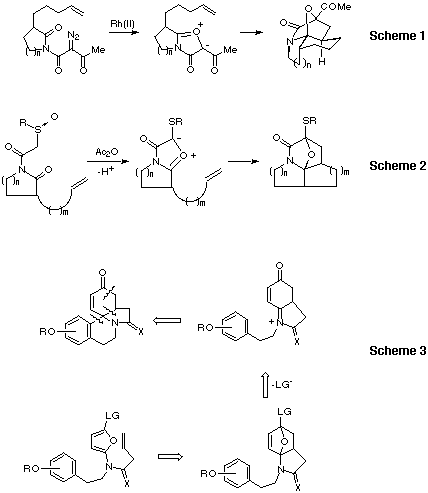Synthesis and properties of novel and biologically important polyaza heterocycles, tandem cascade chemistry, applications of the Pummerer reaction for heterocyclic synthesis, alkaloid chemistry and the cyclization reactions of metallo carbenoids for organic synthesis. Emphasis is placed on new types of synthetic reactions which require a detailed insight into reaction mechanisms. The study of novel heterocyclic compounds represents an ongoing program designed to expand the understanding of the relationship of stereochemistry to chemical reactivity. Research interests also cover several areas of organometallic chemistry, asymmetric synthesis, the mechanism of transition metal catalyzed processes, cycloaddition reactions, applications of molecular orbital theory in organic chemistry, and synthetic organic photochemistry. These investigations embody several disciplines: synthetic methodology, isolation and total synthesis of alkaloids, application of cycloaddition processes for the synthesis of complex molecules and diasteroselective control using metal templates.
Tandem Cascade Chemistry
Tandem reactions are among the most useful synthetic methods available for generating several bonds or rings in a single step. Our recent research efforts have been concerned with the transition metal catalyzed reaction of alpha-diazo ketones and the application of the resulting carbenoid moiety to the selective formation of polycyclic skeletons. The generation of onium ylides by transition metal-promoted cyclization has emerged in our group as an important method for the assembly of ring systems that are difficult or impossible to prepare by other means. Construction of azapoly-heterocycles through metal intervention has been a particularly fruitful area of investigation for the synthesis of various types of alkaloids. Thus, recent papers from these laboratories have described a route to azapolycyclic ring systems that involved the tandem cyclization-cycloaddition of a transient rhodium. IsomŸnchnone dipoles are easily prepared by the rhodium(II)-catalyzed cyclization of suitable diazoimide precursors. This reaction is an integral part of our program aimed at developing new cascade reactions and achieving the total syntheses of various nitrogen-containing heterocycles. Exposure of the diazo ketone to the metal catalyst results in cyclization of the alpha-keto carbenoid to an intermediate in which carbene-like reactivity has been transferred to one of the original alkyne carbon atoms. A neighboring functional group present on the backbone then traps the cyclized intermediate via known carbene chemistry to give various products. The potential for other diverse chemical pathways through the generation and further reaction of these metallo carbenoids are in the process of being studied.
1,3-Dipolar Cycloaddition Chemistry
(Scheme 1) The stereoselective preparation of highly substituted oxygen and nitrogen heterocycles continues to receive significant attention in our research group. Of the numerous strategies for five-membered heterocyclic ring construction, the 1,3-dipolar cycloaddition of carbonyl ylides and azomethine ylides across a C-C 1-bond represents a particularly attractive approach because so many stereocenters can be generated in a single step. Mesoionic dipoles such as isomônchnones are readily generated by the rhodium(II) catalyzed reaction of alpha-diazo amides. By starting with simple acyclic diazoimides, we have established a tandem cyclization-cycloaddition-cationic 1-cyclization protocol as a method for the construction of complex nitrogen polyheterocycles, particularly B-ring homologues of the erythirinane family of alkaloids. Our intention is to study the scope and generality of the method and apply it toward the synthesis of other complex alkaloids.

Pummerer Induced Processes
(Scheme 2) alpha-Acyl thionium ions generated from alpha-acyl sulfoxides under Pummerer conditions are powerful electrophiles, reacting efficiently with a variety of nucleophilic species. Bimolecular addition of these types of cations to carbon-carbon double bonds is well known. In the realm of natural product synthesis, most success has been achieved using intramolecular Friedel-Crafts cyclization of the Pummerer thionium ion intermediate. Recent work in our laboratories involves the internal trapping of the Pummerer thionium ion by adjacent carbonyl groups as a method for generating reactive dienes for subsequent use in Diels-Alder chemistry. The combination of a sequence of individually powerful methods often has a value significantly greater than the sum of the individual reactions and is of current interest to our research program. In the context of our studies dealing with the tandem chemistry of thionium ions, we have discovered that the Pummerer reaction can also be utilized for generating mesoionic dipoles which can be further utilized for alkaloid synthesis.
Amino Furan Cycloadditions
(Scheme 3) Few reactions can compete with the Diels-Alder cycloaddition with respect to the degree of complexity that can be accomplished in a single synthetic step. Carbon-carbon bond forming reactions involving N-acyliminium ions play an equally important role in the synthesis of nitrogen heterocycles and alkaloidal target molecules. A sequential combination of these two powerful synthetic methods would allow for the rapid, stereocontrolled synthesis of a variety of azapolycyclic products. We have used this approach for a highly convergent synthesis of the Erythrina alkaloid ring system. The central feature of this method involves using 2-amino substituted furans which contain both a suitable leaving group (LG) and an olefinic tether to allow for an intramolecular Diels-Alder reaction. The resulting cycloadduct readily undergoes ring-opening to generate a vinylogous C-acyliminium ion. This sequence of reactions allows for a rapid entry into the erythrinane skeleton, where the key ABC ring system is assembled in a single operation and which also allows the oxygen functionality to be placed in the appropriate position as outlined in Scheme 3. Our intention is to use this approach to synthesize a wide assortment of complex alkaloids.
